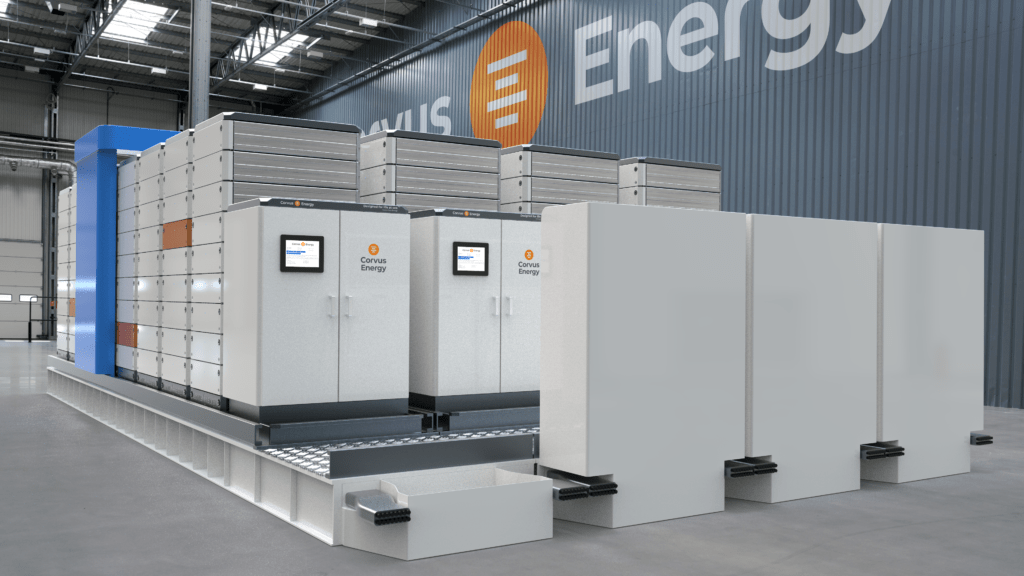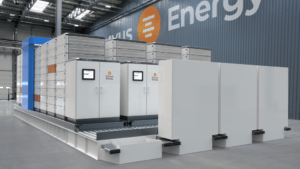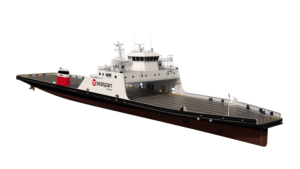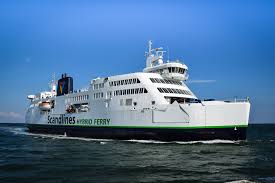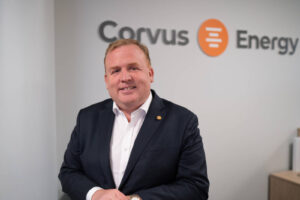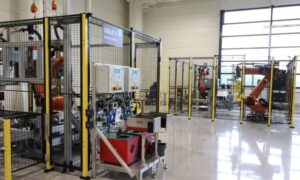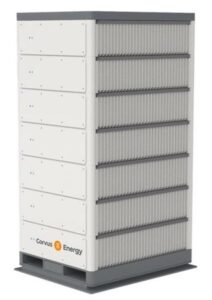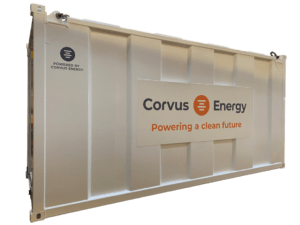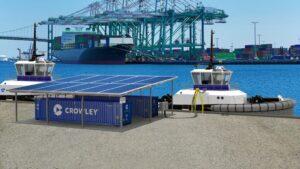Example Pack – Corvus Blue Whale Installation( Photo: Corvus)
BY STAS MARGARONIS
IN THIS REPORT
- BACKGROUND
- EQUINOR
- SHELL
- ROLE OF NORWAY GOVERNMENT
- SEASPAN RELIANT
- CORVUS HISTORY
- CORVUS CEO
- NEW AUTOMATED BATTERY FACTORY
- BATTERY TYPES
- INCREASED CAPACITY
- BATTERY LEASING
- RECYCLING
- NEW BELLINGHAM. WASHINGTON MANUFACTURING FACILITY
- PORT OF BELLINGHAM
- NEW EUROPE MEGA FACTORY
- NEW U.S. FACTORY
- FUEL CELLS
- TOYOTA FUEL CELL COLLABORATION
- CORVUS-CROWLEY TUGBOAT COLLABORATION
Backed by Equinor and Shell, Corvus Energy is expanding its battery installations from ferries and tugboats to cruise ships, wind turbines and even container cranes.
In an interview at the Workboat Show in New Orleans on December 1, 2022, Ole Ingrens, President, Corvus Energy Americas discussed the development of Corvus as a battery provider and the roles of Equinor and Shell: “We are starting to see a whole transformation of the business model. Oil and gas is their primary focus, but they want to also become an energy provider.”
EQUINOR
The Norwegian oil and gas company Equinor, which changed its name from Statoil, announced in 2015 that it was investing in Corvus as part of its expansion into renewable energy:
In 2015, it was announced that Statoil had invested in Vancouver, Canada-based Corvus Energy, a leading battery supplier for the maritime industry. Corvus Energy announced an investment from Statoil for the development of its lithium-ion energy storage systems (ESS) for the offshore oil and gas industry:
“‘We are very pleased to invest in Corvus Energy, a recognized leader in large-scale energy storage systems for marine applications. Its products and unparalleled expertise give them a competitive advantage for expanding into the offshore sector,’ said Richard Erskine, managing director of Statoil. He added: ‘We see initial applications in vessels, with long term potential to apply the same technology to rigs and platforms, which will contribute to Statoil’s ambition to reduce CO2 emissions.’”[1]
Equinor ASA (formerly Statoil and StatoilHydro) is a Norwegian state-owned multinational energy company headquartered in Stavanger. It is primarily a petroleum company, operating in 36 countries with additional investments in renewable energy. In the 2020 Forbes Global 2000, Equinor was ranked as the 169th-largest public company in the world. As of 2021, the company had 21,126 employees.[2]
The current company was formed by the 2007 merger of Statoil with the oil and gas division of Norsk Hydro. As of 2017, the Government of Norway is the largest shareholder with 67% of the shares, while the rest is public stock. The ownership interest is managed by the Norwegian Ministry of Petroleum and Energy.[5] The company is headquartered and led from Stavanger, while most of their international operations are currently led from Fornebu, outside Oslo.[3]
Equinor reported revenues of $90 billion in 2021[4]
Ingrens said the Norwegian companies “pushed for more of a focus of the Corvus business on Norway as a hub into Europe. And so, the headquarters was moved to Norway from Vancouver. And the company recruited a bunch of people that have a wider marine DNA, including ship designers and integrators.”
The American Journal of Transportation reported that in October 2017, Equinor was investing in a floating offshore wind project in Scotland and started to deliver power to the Scottish electricity grid. The “Hywind” pilot wind project marks an important step forward for offshore wind technology, potentially opening attractive new markets for renewable energy production worldwide:
“Equinor has installed a floating wind farm consisting of five turbines at Buchan Deep, 25 km offshore Peterhead, harnessing Scottish wind resources to provide renewable energy to the mainland. With 30 MW installed capacity, the wind farm will be able to power the equivalent of around 20,000 households.”[5]
The AJOT news report also noted that renewable products and companies are being financed by a new investment firm: “Equinor Energy Ventures is one of the world’s largest corporate venture funds dedicated to investing in attractive and ambitious growth companies in renewable energy.”
Established in 2016, the investment firm reflects: “the company’s aspirations to gradually complement its oil and gas portfolio with profitable renewable energy and low-carbon solutions.”
It was capitalized with US $200 million and projects:
- Investing US$ 1-20 million per company
- Investing over a period of 4-7 years[6]
SHELL
In 2019, Corvus announced a new investment from Shell.
At that time Geir Bjørkeli, CEO of Corvus Energy, hailed having Shell Ventures as one of the strategic investors:
“To have strong and active owners has been crucial to our success and has taught us that by working closely with strategic investors we can achieve great results. A good example is what we achieved with Equinor, which has now become the model and inspiration for the rest of the world … To have Shell onboard as an investor means that we can reach out to a much larger market and apply our technology to more rigs and platforms as well as continue the hybridization of offshore vessels. We look forward to working with Shell to power a clean future and support Shell’s determination to make their operations more sustainable.”[7]
ROLE OF NORWAY GOVERNMENT
Ingrens said the Government of Norway “put into place a lot of incentives to encourage the development of electric power ferries. In the offshore oil and gas industry, batteries have proved capable of reducing costs because of the redundancy that requires keeping diesel powered generators in operation. By switching over to batteries you can reduce the costs and the emissions. So, if there was a double win, you could reduce maintenance costs and fuel costs.”
SEASPAN RELIANT
Rendering Seaspan
In 2017, Corvus Energy provided battery power for a Canadian roll on roll off ferry the Seapsan Reliant which carries up to 800 trailers per day between Vancouver Island and the British Columbia Mainland.
A 2017 Workboat magazine report noted:
“Designed by Vard Marine and sporting a draft of 7m (23′), the steel monohull Seaspan Reliant is an LNG-battery hybrid cargo ferry that features two dual-fuel engines and a Corvus lithium-ion energy storage system (ESS), which operates as spinning reserve and provides propulsion power for low-speed maneuvers. Corvus provides high power energy storage in the form of modular lithium-ion battery systems. Its purpose built, field proven battery systems are designed to provide sustained power to hybrid and fully electric heavy industrial equipment, including large marine propulsion drives. In this case, the engines connect to azimuthing drives that give the ferry a running speed of 16 knots. The new ferry has capacity for 59 53′ truck trailers …”[8]
In 2018, Corvus Energy “started to develop the next-generation energy storage system (ESS) for maritime applications. The process has focused on cost-effectiveness, scalability and safety, as well as flexibility and sustainability. The first product in this series, the Corvus Blue Whale ESS, is designed for large installations and is now ready for delivery after successful sea trials on board Seaspan Reliant, a drop-trailer cargo ferry owned and operating (sic) by Seaspan Ferries Corporation (SFC). On October 15 and 16, SFC, Corvus Energy and integrator Elkon conducted tests of a suite of sea-trial requirements for the Corvus Blue Whale ESS, resulting in successful completion of customer acceptance testing…”[9]
CORVUS HISTORY
Ole Ingrens
Ingrens explained that Corvus began its operations in Canada:
“A lot of the battery R&D had been developed in Canada and made Canada the R&D center. The resources for production development of batteries is in Canada. So what we have today is the Canada team develops the battery technology and the Norway team puts the batteries into the maritime solution and space.”
The Corvus website says the initial battery production company was founded in 2009 in Vancouver, Canada and the very first marine installation the Hybrid Tug Campbell Foss for Foss Maritime was made in 2011.
The history goes on to say that:
Corvus’ AT6500 was the first maritime battery to be launched. The challenge was to create a battery that was scalable to several sizes and rugged enough to survive in marine applications. Price/kwh was too high to make it scalable and adoption was slow.
Photo: Scandlines
In 2013, the Prinsesse Benedikte, which Corvus said was the “World’s first 1000+ passenger Hybrid Ferry” was deployed with a 2.6MWh ESS … Delivery of Energy Storage System for Prinsesse Benedikte, a ferry retrofitted in Copenhagen in May 2013. The vessel is owned by Scandlines and sails the Puttgarden–Rødby route together with five other battery hybrid ferries.”
Also in 2013, Corvus Energy was introduced to Chinese container crane builder ZPMC “to make hybrid port cranes for the Chinese container crane builder.”
In 2015, Corvus Energy supplies the battery system for the world’s first all-electric ferry, Ampere. Operating cost is reduced by 60% and emissions by 95% compared to a traditional diesel ferry, Corvus says.[10]
The project is supported by Norway’s Ministry of Transportation.[11]
In 2015, Corvus established an office in Bergen, Norway.[12]
Ingrens explains that the battery cells that Corvus buys come from a South Korean battery cell supplier: “We buy from LG in South Korea (although the cells) are made in China, so that they make it in either Korea or China. But most of those cells are from China. So, the supply chain is denominated by Asia because most ships are built in Asia.”
CORVUS CEO
In 2017, Geir Bjørkeli, a 20-year veteran of marine systems, took the helm of Corvus Energy as its new Chief Executive Officer (Photo: Corvus Energy)
Ingrens and Bjørkeli were colleagues at Rolls Royce, Ingrens said.
Bjørkeli was previously Director of Norway for the Dutch company Huisman, and established the company’s Norwegian presence for offshore construction equipment solutions. Bjørkeli is based in Bergen, Norway.
Prior to joining Huisman, Bjørkeli was a design engineer with the ship designer and shipbuilder Ulstein. He held several positions with Rolls-Royce, including VP Sales for North East Asia and Managing Director of Rolls-Royce Marine Japan, during which time he was based in Korea for six years and Japan for two years. Subsequently, he was appointed VP Systems Sales & Marketing Campaigns with global responsibility for Rolls-Royce systems in merchant vessels.[13]
NEW AUTOMATED BATTERY FACTORY
In 2019, Corvus opened a battery factory in Bergen, Norway. The company said in a news release that the factory “will supply Corvus’ largest market—the growing European market—and contribute to employment in Bergen and across Northern Europe. Built on time and on budget, the factory comprises a robotized and digitized production line with nine robotic stations and a capacity of up to 400 megawatt hours (MWh) per year. From unpacking incoming parts to testing the finished battery module, the entire factory is completely automated.”[14]
The automated Corvus battery factory comprises nine robotic stations and has a production capacity of 400 MWh annually. (Photo: Corvus Energy)
The Corvus Vancouver, Canada facility “will continue to supply North American and Asian markets, where demand for hybrid and zero-emission solutions is emerging and expected to grow rapidly. Further, Corvus is expanding its Vancouver R&D center and will continue to manufacture the prototypes and production runs of new products.”[15]
Ingrens noted: “We opened a large new facility in Norway for production three years ago and the primary product was the Orca batteries which is our best-selling product that has been around since 2017. We have the Dolphin battery which is the newer product.”
He said the Bergen factory “is a fully automated manufacturing space. Corvus realized that the marine industry is still relatively small compared to the automotive industry. So, the decision was made that we are not going to go into that battery cell part of the supply chain and we are going to follow the trend in other industries and use the best that’s out there in cells.”
BATTERY TYPES
Ingrens discussed the modular strategy for batteries:
“Our core focus and added value is really putting that battery cell into a maritime application. We source our battery cells from South Korea. We have a module and in the module there’s many cells and 24 cells typically.
And that module is what we have put together and then you put the module into a system and then you have that battery management system. That’s our proprietary technology. The cell technology is developing so fast that we want to standardize the products better and leave that kind of cell technology open so if we see something better come to the market, we can adapt that into the product without changing the whole product.
Our projects are very modular. They are like LEGO blocks. There are two dimensions:
- You want a lot of energy for storage for power that you use over a long period of time. Then you might have a larger ferry that goes many, many hours and typically those will be hybrid ships. So, you might use your engines on board to charge or you might have an application where you charge overnight. you don’t have to have those large, fast charging batteries … The Washington State car ferries might be an example of the larger ferries.
- High Power. Second is a battery where you need a high burst of power and where you (have) fast discharging or charging rates. So, if you have an electric ferry, going from point A to point B, you’ve got to have a fast-charging capability that’s fairly quick and in about 20 minutes.
Ingrens says the battery market has taken off: “In the last three years we have delivered as many systems as we have delivered in the last 10 years. The market is at the point where it is growing exponentially and with that we have been thinking about our next step investment.“
INCREASED CAPACITY
Ingrens says that: “So in terms of weight, compared with the first-generation of batteries, we are now today seeing weight reductions of 70%, and I think we will see another 30% reduction.”
Prices for lithium batteries have risen: “if you look at lithium prices, they have gone up dramatically. So, we have had to set up price lines in the battery world and I think it has stabilized. And we are hopeful that we can get the cost down again. But we can’t control the cell prices so much like with (Korean battery cell maker) LG but we can’t control the other parts…. that’s why we think it’s important to build up local presence in the market that we are in … we are seeing that you can get more power per volume metric. … even though the price of batteries has gone up, the price per power has come down.”
BATTERY LEASING
In ships, he says, “the batteries can help reduce your operating costs but you are increasing your capital expenditures so you need to find an incentive to get over the hump. So, one idea that we are looking at is to have a leasing system … The shipowner can pay a fixed charge or pay by the kilowatt and then you could switch out the batteries every five years or so. That would allow us to have a say in how shipowners use the batteries, so as to optimize the batteries and so as to lock in the resale value. So, batteries wear down every year … So when the battery reaches 10 years of life, it still has 70% capacity. So, it won’t match the way it was designed anymore unless you change the requirements but it is still a useful battery and so another factor is to find a second market for these batteries … That could be for storage, for a power plant or for a skyscraper. So if we can extend the revenue flow of the batteries then we could lower the price.
RECYCLING
Corvus is looking at recycling batteries to improve cost competitiveness:
“And the third factor I would highlight is recycling …These batteries that we are developing we say are 97% recyclable. The problem is that the infrastructure isn’t there yet. In Norway we have now some recycling process and there are some efforts going on in the U.S. With the exponential rise in battery sales, the supply chain will collapse without a proper recycling plan, so you need to recycle these materials back into the supply chain.”
NEW BELLINGHAM. WASHINGTON MANUFACTURING FACILITY
In 2022, bringing batteries closer to the U.S. market in part motivated ‘Buy American’ requirements, motivated Corvus:
“To do something in the U.S. … we decided that we had the old production line in Vancouver, Canada that was used for the Orca (battery) project. It’s not like the Bergen facility which is fully automated. This is a manual line but has still been kept up to line so we have moved the product across the border to Bellingham, Washington.”
PORT OF BELLINGHAM
And so, the Port of Bellingham was selected because “they had a nice facility waiting for us and we got a grant to run that facility and it is now up and running. By June (2023) we should have 15 or 16 people and it is very scalable. And we are producing the Orca batteries there and they are the fast-charging batteries. So, it is a battery that was designed in 2017, so it is not next generation.
DOLPHIN AND BLUE WHALE BATTERIES
Corvus says that the Dolphin Power ESS is specifically designed for lightweight applications. Dolphin Power combines outstanding power density and a reasonable energy density with the highest level of safety, setting a new industry standard for maritime energy storage systems.
.The flexible design of the Dolphin Power allows the system to be stacked in various directions enabling high space efficiency in compact installations. Dolphin Power is ideal for high-speed vessels that need to boost propulsion to reach max speed, or vessels that must recharge the batteries quickly and often.
Dolphin Power is ideal for vessels where light weight is essential but where high charge or discharge power is also required. Typical vessels are:
- Fast ferries
- Ferries
- Yachts
- Tourist vessels
- Cruise ships
- Sightseeing vessels
Its features include:
- High C-Rate, up to 4.4C peak
- Low weight
- Designed for voltages up to 1000 VDC
- Flexible installation
- Low life cycle cost
- Easy and safe plug and play connections
- Very flexible and modularised (sic) design
- Passive single-cell Thermal Runaway protection
- Reduces fuel, emissions, noise and maintenance
- Industry-proven Battery Management System (BMS)
- Remote monitoring
Dolphin and Blue Whale are the next generation batteries, Ingrens said adding:
“The Blue Whale is the large, energy storage capacity and we are looking at vessels that don’t need fast changing or discharging. This application could be a large ferry, a cruise ship, could be an offshore wind installation.So, we had our first successful sea trial with the Blue Whale battery a couple of months ago.”
Corvus says the Corvus Blue Whale Energy Storage System is specifically designed to meet the large energy requirements of emission-free operation over longer periods of time.
Corvus Blue Whale ESS (Photo; Corvus Energy)
The Corvus Blue Whale ESS differs from other ESS technologies available in the market in that it is specifically designed for use in vessels like Cruise, Ro-Pax, Ro-Ro, Mega Yachts, etc. where the operational profiles cater for slow charge and discharge rates and a product that enables emission-free sailing over longer periods of time and/or emission-free port stays. [16]
Ingrens said that one of the original battery installations that Corvus made was in a Seaspan ferry “so we took out the old Corvus battery that was installed … and we put in a Blue Whale battery that has much bigger capacity.”
NEW EUROPE MEGA FACTORY
Ingrens said Corvus is “planning a new mega-factory in Europe in 2025 that will produce all the products.”
NEW U.S. FACTORY
And the company is “planning to build a large factory in the U.S we haven’t decided yet but Texas is one option because it is a logistics center.”
FUEL CELLS
The strategic rationale for Corvus is that fuel cells and batteries go together:
“You can use fuel cells to charge the batteries and you don’t need to rely on charging at the shore. You can do the charging with hydrogen. So, the first technologies that are out there are using hydrogen and of course hydrogen is complicated.”
The problem with hydrogen is that: “It’s difficult to contain and there is some safety aspects to it.”
TOYOTA FUEL CELL COLLABORATION
On its website, Toyota recalls that it began its fuel cell development around the same time as its original Prius car nearly 25 years ago, and the fuel cell-drive Toyota Mirai shares technology from the company’s hybrid program:
“Toyota developed the solid-polymer electrolyte fuel cells used in the first- and second-generation Mirai models. To help foster … proliferation, the company has released over 5,000 of its patents, royalty-free.
It is a scalable technology that can be made small enough to power a phone or large enough to power a building, or anything in between. For example, Toyota installed fuel cell powertrains in a fleet of class-8 semi-trucks that are rated for a maximum 80,000-pound load. These big rigs have been used for moving freight in and around the Ports of Los Angeles and Long Beach, California.
Hydrogen can be produced from a variety of domestic resources. The goal of the Hydrogen Council, for which Toyota is a founding member, is to use decarbonized hydrogen for transportation such as that produced from bio-resources or renewable electricity via electrolysis by 2030.” [17]
Ingrens said that about a year and a half ago, Toyota came to Corvus and knocked on the door saying Toyota saw “potential growing in the marine industry but we really don’t have marine knowledge and we don’t have a route to market. Would Corvus be interested in becoming Toyoda’s route to market?”
So Corvus took the “Toyota standard fuel cell for the Toyoda Mirai and we marinized it. So we are going to put these fuel cells in a container and then apply it to marine applications together with batteries, so that’s what we have done. “
Corvus has “a testing facility for fuel cells in Norway and we are hoping to sell our first pilot next year. And we are looking at extracting hydrogen from other fuels like ammonia and we are working on that too. So as companies tap into different fuels you can also tap into different fuel cells with different fuels … we are seeing some applications for fuel cells in tugboats, where you don’t need huge volumes of fuel or you have access to charging … sightseeing boats and tugboats.”
CORVUS-CROWLEY TUGBOAT COLLABORATION
Corvus Orca BOB is a plug-and-play battery room, available in standard 10’ or 20’ container footprints containing 744 kWh and 1492 kWh respectively and capable of fast discharge/charging. © Corvus Energy
In November, Corvus announced participation “in the innovative Crowley eWolf zero-emission tugboat project has expanded with an order to supply shoreside battery energy storage systems (ESS) using two Corvus Orca BOBs—the containerized version of its market-leading Corvus Orca ESS—with a total energy storage capacity of 2,990 kWh.”[18]
The company said the Crowley eWolf, the first all-electric tug in the U.S., and its shoreside charging infrastructure will go into service in San Diego’s harbor in 2023. Corvus Energy is also supplying the 6.2 MWh Corvus Orca ESS on board eWolf. The vessel is under construction at Master Boat Builders, with electrical integration provided by ABB.
“The use of the Corvus Orca ESS shoreside will allow eWolf to charge quickly, potentially avoiding the need to upgrade the electricity grid infrastructure at the port,” Ingrens said adding: “Since the Orca ESS has a high C-rate, it is capable of discharging quickly and safely so that eWolf will be quickly recharged and returned into service.”
Photo: Crowley
The eWolf and the shoreside infrastructure are designed to allow the vessel to operate fully electric with full performance capabilities, as well as draw energy at off-peak hours from the energy grid. The eWolf is a result of a partnership among Crowley, the San Diego County Air Pollution Control District, the California Air Resources Board, the Port of San Diego, the U.S. Environmental Protection Agency and the U.S. Maritime Administration, which all provided financial support and other resources.[19]
OFFSHORE WIND
A new market for Corvus batteries, Ingrens said, is offshore wind “which is ideal for battery operations because you have a very predictable profile.”
He went on to explain:
“So (wind turbine) installation vessels have a pattern that you can use for charging in the wind park itself or in and out to shore … many offshore wind parks are now looking at fully electric vessels for their offshore needs.
He explained that batteries can support more continuous power generation from wind turbines:
“So for the wind parks, one of the problems with wind is that it is not stable. So one idea that we are working with a couple of developers on is putting batteries on the wind turbine itself. And even fuel cells if you have a turbine that can produce 10 megawatts … one of the concepts that some developers are looking at is that they will only produce 8 megawatts and you will use 2 megawatts when you have a lot of wind to charge the batteries so that means that when there is no wind that they can still guarantee input into the grid and that makes it easier for the developers to plan around the wind parks.”
As a point of reference One megawatt (MW) = 1,000 kilowatts = 1,000,000 watts and can provide power for an estimated 400-900 homes per year.[20]
Ingrens explains that “even though we focus on marine, that’s an application that’s perfect for us.”
FOOTNOTES
[1] https://www.ajot.com/premium/ajot-statoil-equinor-plans-12-billion-in-renewable-energy-projects
[2] https://en.wikipedia.org/wiki/Equinor
[3] https://en.wikipedia.org/wiki/Equinor
[4] Ibid
[5] https://www.ajot.com/premium/ajot-statoil-equinor-plans-12-billion-in-renewable-energy-projects
[6] https://www.ajot.com/premium/ajot-statoil-equinor-plans-12-billion-in-renewable-energy-projects
[7] https://corvusenergy.com/shell-ventures-invests-in-corvus-energy/
[8] https://www.workboat.com/shipbuilding/seaspan-takes-delivery-second-ferry
[9] https://corvusenergy.com/corvus-blue-whale-ess-completes-sea-trials-on-board-seaspan-reliant/
[10] https://corvusenergy.com/about/history-2/#:~:text=Corvus%20Energy%20is%20founded%20in,the%20start%20of%20Corvus%20Energy.
[11] https://archive.nordregio.se/en/Publications/Publications-2016/GREEN-GROWTH-IN-NORDIC-REGIONS-50-ways-to-make-/Clean-tech-and-renewable-energy–/Amper/index.html
[12] https://corvusenergy.com/about/history-2/#:~:text=Corvus%20Energy%20is%20founded%20in,the%20start%20of%20Corvus%20Energy.
[13] https://corvusenergy.com/corvus-energy-announces-a-new-ceo/
[14] https://corvusenergy.com/corvus-energy-opens-a-new-battery-factory-in-norway/
[15] https://corvusenergy.com/corvus-energy-opens-a-new-battery-factory-in-norway/
[16] https://corvusenergy.com/products/energy-storage-solutions/corvus-blue-whale/
[17] https://pressroom.toyota.com/zero-emissions-in-style-2022-toyota-mirai-pricing-announced/
[18] https://corvusenergy.com/corvus-containerized-ess-will-supply-shore-power-for-crowley-ewolf-all-electric-tug/
[19] https://corvusenergy.com/corvus-containerized-ess-will-supply-shore-power-for-crowley-ewolf-all-electric-tug/

